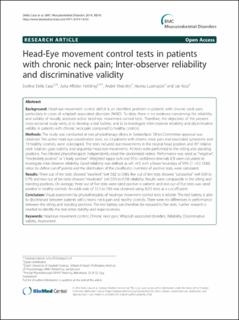Please use this identifier to cite or link to this item:
https://doi.org/10.21256/zhaw-1933| Publication type: | Article in scientific journal |
| Type of review: | Peer review (publication) |
| Title: | Head-eye movement control tests in patients with chronic neck pain : inter-observer reliability and discriminative validity |
| Authors: | Della Casa, Evelyne Affolter Helbling, Jutta Meichtry, André Luomajoki, Hannu Kool, Jan |
| DOI: | 10.21256/zhaw-1933 10.1186/1471-2474-15-16 |
| Published in: | BMC Musculoskeletal Disorders |
| Volume(Issue): | 15 |
| Issue: | 16 |
| Issue Date: | 2014 |
| Publisher / Ed. Institution: | BioMed Central |
| ISSN: | 1471-2474 |
| Language: | English |
| Subjects: | Head-eye movement control; Chronic neck pain; Whiplash associated disorders; Reliability; Discriminative validity; Assessment |
| Subject (DDC): | 617.5: Orthopaedic surgery |
| Abstract: | Background: Head-eye movement control deficit is an identified problem in patients with chronic neck pain, particularly in cases of whiplash associated disorders (WAD). To date, there is no evidence concerning the reliability and validity of visually assessed active head-eye movement control tests. Therefore, the objectives of the present cross-sectional study were, a) to develop a test battery; and b) to investigate inter-observer reliability and discriminative validity in patients with chronic neck pain compared to healthy controls. Methods: The study was conducted at two physiotherapy clinics in Switzerland. Ethics Committee approval was obtained. Ten active head-eye coordination tests, on 23 patients with chronic neck pain and associated symptoms and 19 healthy controls, were videotaped. The tests included eye movements in the neutral head position and 45° relative neck rotation, gaze stability and sequential head-eye movements. All tests were performed in the sitting and standing positions. Two blinded physiotherapists independently rated the randomized videos. Performance was rated as "negative", "moderately positive" or "clearly positive". Weighted kappa (wK) and 95% confidence intervals (CI) were calculated to investigate inter-observer reliability. Good reliability was defined as wK >0.5 with a lower boundary of 95% CI >0.2. Odds ratios (to define cut-off points) and the distribution of the classificator, numbers of positive tests, were calculated. Results: Three out of ten tests showed "excellent" (wK 0.82 to 0.86), five out of ten tests showed "substantial" (wK 0.69 to 0.79) and two out of ten tests showed "moderate" (wK 0.54 to 0.59) reliability. Results were comparable in the sitting and standing positions. On average, three out of five tests were rated positive in patients and one out of five tests was rated positive in healthy controls. An odds ratio of 13.3 to 18.6 was obtained using ≥2/5 tests as a cut-off point. Conclusion: Visual assessment by physiotherapists of head-eye movement control tests is reliable. The test battery is able to discriminate between patients with chronic neck pain and healthy controls. There were no differences in performance between the sitting and standing positions. The test battery can therefore be reduced to five tests. Further research is needed to identify the test-retest stability and responsiveness. |
| URI: | https://digitalcollection.zhaw.ch/handle/11475/4851 |
| Fulltext version: | Published version |
| License (according to publishing contract): | CC BY 2.0: Attribution 2.0 Generic |
| Departement: | School of Health Sciences |
| Organisational Unit: | Institute of Physiotherapy (IPT) |
| Appears in collections: | Publikationen Gesundheit |
Files in This Item:
| File | Description | Size | Format | |
|---|---|---|---|---|
| 2014_Della Casa_Head-eye movement_BMC Musculoskeletal Disorders.pdf | 1.28 MB | Adobe PDF |  View/Open |
Show full item record
Della Casa, E., Affolter Helbling, J., Meichtry, A., Luomajoki, H., & Kool, J. (2014). Head-eye movement control tests in patients with chronic neck pain : inter-observer reliability and discriminative validity. BMC Musculoskeletal Disorders, 15(16). https://doi.org/10.21256/zhaw-1933
Della Casa, E. et al. (2014) ‘Head-eye movement control tests in patients with chronic neck pain : inter-observer reliability and discriminative validity’, BMC Musculoskeletal Disorders, 15(16). Available at: https://doi.org/10.21256/zhaw-1933.
E. Della Casa, J. Affolter Helbling, A. Meichtry, H. Luomajoki, and J. Kool, “Head-eye movement control tests in patients with chronic neck pain : inter-observer reliability and discriminative validity,” BMC Musculoskeletal Disorders, vol. 15, no. 16, 2014, doi: 10.21256/zhaw-1933.
DELLA CASA, Evelyne, Jutta AFFOLTER HELBLING, André MEICHTRY, Hannu LUOMAJOKI und Jan KOOL, 2014. Head-eye movement control tests in patients with chronic neck pain : inter-observer reliability and discriminative validity. BMC Musculoskeletal Disorders. 2014. Bd. 15, Nr. 16. DOI 10.21256/zhaw-1933
Della Casa, Evelyne, Jutta Affolter Helbling, André Meichtry, Hannu Luomajoki, and Jan Kool. 2014. “Head-Eye Movement Control Tests in Patients with Chronic Neck Pain : Inter-Observer Reliability and Discriminative Validity.” BMC Musculoskeletal Disorders 15 (16). https://doi.org/10.21256/zhaw-1933.
Della Casa, Evelyne, et al. “Head-Eye Movement Control Tests in Patients with Chronic Neck Pain : Inter-Observer Reliability and Discriminative Validity.” BMC Musculoskeletal Disorders, vol. 15, no. 16, 2014, https://doi.org/10.21256/zhaw-1933.
Items in DSpace are protected by copyright, with all rights reserved, unless otherwise indicated.